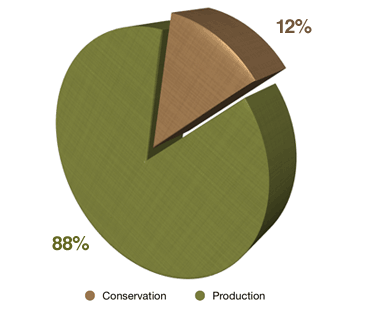MAKING IT RIGHT – Page 2
A Bountiful Harvest of Crops and Cash
If the goal of federal farm policy since 1997 has been to extract every last bushel from every acre, then it has succeeded. Iowa’s corn production increased from 1.66 billion bushels that year to 2.44 billion bushels in 2009 — 47 percent. In the Corn Belt as a whole, corn production grew by 40 percent.
For farmers, it has been a bountiful harvest — of crops and cash. Farm household income has been above average U.S. household income every year since 1996. The five best years ever for farm income have all come since 2003.49
It has also been a bountiful harvest of taxpayers’ cash, with most of it going to farm households that are doing far better than the average American family. The average household income of farms that received $30,000 or more in government payments in 2008 was above $210,000 — more than three times the average of all households ($68,424). Farms with household incomes of $110,000 received between $10,000 and $29,999 on average in government payments.50
Voluntary Programs Plowed Under
The few chronically underfunded federal conservation programs in place are inadequate to blunt the damage caused by federal policies that push farmers to plant their crops fencerow to fencerow. Between 1997 and 2009, the government paid Iowa farmers $2.76 billion to put conservation practices in place. It paid out seven times as much — $16.8 billion — in income, production and insurance subsidies that encouraged maximum- intensity planting, not conservation. Across the Corn Belt, the gap was even greater — $7.0 billion for conservation and $51.2 billion for income, production and insurance subsidies.51

In 2008 alone, the two most important conservation programs — the Conservation Reserve Program (CRP) and the Environmental Quality Incentives Program (EQIP) — spent $208.8 million and $19.6 million respectively in Iowa to help farmers implement good conservation practices. Farmers got 4.5 times more — $1.03 billion — in production-related subsidies. The same imbalance holds true across the Corn Belt. The region’s farmers got $3.1 billion in subsidies in 2008 — 5.3 times as much as the $522.7 million in CRP assistance and the $69.6 million in EQIP payments.52
Congressional promises to increase funding for conservation have never been kept. These programs have been funded below the authorized levels every year since 2002. From 2002 to 2010, Congress fell $2.55 billion short of the conservation commitments made in the 2002 and 2008 farm bills. If funding cuts planned for 2011 go through, the appropriations will be more than $1 billion short.53
Not coincidentally, there have been significant cuts in the NRCS staff that provides the technical expertise needed to produce effective conservation plans and ensure that the prescribed practices are properly implemented and maintained. Agency staffing declined by 8 percent between 1995 and 2009 despite a dramatic increase in the number, size and complexity of programs.54
Back to Basics
Voluntary programs and technical help from government technicians and scientists cannot hold soil and water together in the face of the pressure to push the land harder and harder. The pressure for all-out production is intensified by the profound changes in land ownership. Meanwhile conservation programs are being overwhelmed by misguided farm and biofuel policies that magnify the perverse incentives of a marketplace that turns a blind eye to soil degradation and water pollution.
It is time to make sure that the most basic, simple and traditional conservation practices that hold soil and watersheds together are in place everywhere they are needed. Science tells us that such practices would result in a big improvement in protection of the environment and in sustaining agricultural production in an increasingly dangerous climate. These conventional practices will not solve all the problems we confront, but they will go a long way to building the foundation on which more targeted efforts can be placed.
It is also time to go back to what works — requiring farmers to protect soil and water in return for the billions in income, production and insurance subsidies that taxpayers put up each year. It was good policy in 1985 and it is even more so now.

 Twitter Updates
Twitter Updates

